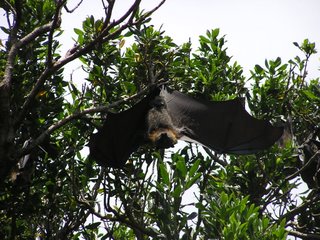Disaster Bay and Green Cape
On 21st October Simon and I set off for the final phase of my Australian venture. The objective was Green Cape via Kiama, Bateman's Bay and Eden.
Our first stop en route was at the Barren Grounds Nature Reserve on the Buderoo Plateau inland from Kiama and Jamberoo. Despite its name, the reserve is far from barren as it represents one of the remaining extensive stands of dry mountain heathland in southern Australia and is habitat of the rare and endangered Ground Parrot and Eastern Bristlebird. Not lucky enough to see either on this occasion we nevertheless found a number of interesting species (for example Swamp Harrier and Beautiful Firetail) and many of the spring flowers were in full bloom.
Our first stop en route was at the Barren Grounds Nature Reserve on the Buderoo Plateau inland from Kiama and Jamberoo. Despite its name, the reserve is far from barren as it represents one of the remaining extensive stands of dry mountain heathland in southern Australia and is habitat of the rare and endangered Ground Parrot and Eastern Bristlebird. Not lucky enough to see either on this occasion we nevertheless found a number of interesting species (for example Swamp Harrier and Beautiful Firetail) and many of the spring flowers were in full bloom.
Our journey south along the coast of the Tasman Sea was interspersed with camps, always within earshot of the roar of the ocean breakers. Eating was usually a huge steak on the 'barbie' but who could resist the occasional lobster, bag of oysters or prawns, or a fillet of fresh snapper at the seafood takeaways at Ulladulla or Bateman's Bay!
Campsites often proved good for birding (e.g. we found Dollarbird and Whipbird at a campsite) as well as other wildlife like wallabies, snakes, bats and wombats.

A wombat emerges from the bush at dusk to graze around the camp site
The journey down to Green Cape was punctuated with many birding opportunies in the numerous creeks, estuaries lakes and swampy bits. The southward migration of wading birds from the Arctic to spend the northern winter in warmer climes was already in evidence as groups of Bar-tailed Godwits, Sharp-tailed Sandpipers and Eastern Curlews (much longer bill than our Eurasian Curlew) were in evidence. Wallagoot lake was memorable for finding the endangered Little Tern whilst having to run the gauntlet with a thunderstorm!
Eventually we made our way to Green Cape which forms the northern arm of Disaster Bay (so called because of numerous shipwrecks before the construction of the Green Cape lighthouse in 1883 - pictures and history here) and set up camp in the Ben Boyd National Park, close to the cape. The outlook onto Disaster Bay is spectacular, revealing golden sand and unbroken forest reaching the shoreline as far as the eye could see. From the ecologist's eye, the succession of vegetation developing inland from the continous generation of sand dunes was fascinating.
It was here at the cape that we had some of the most memorable wildlife-watching experiences. Tens of thousands of Short-tailed Shearwaters ("Tasmanian Mutton Birds") were migrating close past the headland, moving south from their wintering areas in the Pacific to breeding grounds on islands in sub-Antarctic waters. Other birds on the move were Crested Terns, Australasian Gannets, Sooty Oystercatchers, two or three Sea Eagles and even an Arctic Skua, already arrived from its northern breeding grounds.
Just offshore a pod of Sealions were lazing in the sea (one came out onto the rocks) and just as we were about to leave, a huge whale breached, cascading a tower of water high into the air, an unforgettable sight!
Just offshore a pod of Sealions were lazing in the sea (one came out onto the rocks) and just as we were about to leave, a huge whale breached, cascading a tower of water high into the air, an unforgettable sight!
This is my final blog entry from Australia. Looking back over the last four weeks, it is hard to pinpoint a "best moment", so many come to mind. Emus and Apostlebirds at Wilga; the camp by the billabong on the Paroo River; budgerigars coming to drink at the water holes at Mount Wood National Park; the climb up Mount Wood itself, in the searing heat and unremitting flies; the trip to Cameron Corner at the edge of the endless Strzelecki Desert; Regent Parrots and Yellow Rosellas at the Hattah National Park; an internet cafe at Mildura; waterfowl and the colourful Orange Chat at Copi Hollow in the Kinchega National Park; the desolate 'Wall of China' formations in the dunes at the Mungo National Park; finding the sought-after Rockwarbler at Wheeny Creek in the Blue Mountains.... and so many more.
In any event the dramatic seawatching experience at Green Cape was certainly a fitting climax. The final bird species list total is 205, including 18 species of parrot - far greater than anticipated!
This trip could not have been possible, let alone enjoyable, without the kind hospitality of the Cotter family who made me feel so welcome and at home in the Blue Mountains. My grateful thanks indeed go to them all.
In any event the dramatic seawatching experience at Green Cape was certainly a fitting climax. The final bird species list total is 205, including 18 species of parrot - far greater than anticipated!
This trip could not have been possible, let alone enjoyable, without the kind hospitality of the Cotter family who made me feel so welcome and at home in the Blue Mountains. My grateful thanks indeed go to them all.

The Cotter family, clockwise: David, Tom, Rosalie, Susanna, Bonny, Simon and me.




















